Google's Tensor inside of Pixel 6, Pixel 6 Pro: A Look into Performance & Efficiency
by Andrei Frumusanu on November 2, 2021 8:00 AM EST- Posted in
- Mobile
- Smartphones
- SoCs
- Pixel 6
- Pixel 6 Pro
- Google Tensor
GPU Performance & Power
The Google Tensors GPU is quite a beast. A Mali G78 with 20 cores, it’s sporting 42% more cores than the Exynos 2100 implementation, and only comes second after HiSilicon’s Kirin 9000. However, unlike the more power efficient N5 process node of the Kirin 9000, the Tensor SoC comes on the same process node as on the Exynos 2100. Having a much larger GPU, one would expect Google to drive the block at lower frequencies, in order to achieve better energy efficiency. To our surprise, the G78MP20 runs at up to 1GHz on the tiler and L2, and up to 848MHz on the shader cores, which is essentially the same as the smaller Exynos 2100 implementation of the GPU. Of course this immediately raises red flags for the Tensor when it comes to power consumption, as the chip certainly can’t pull out a rabbit out of a hat in terms of efficiency, so let’s see what happens:
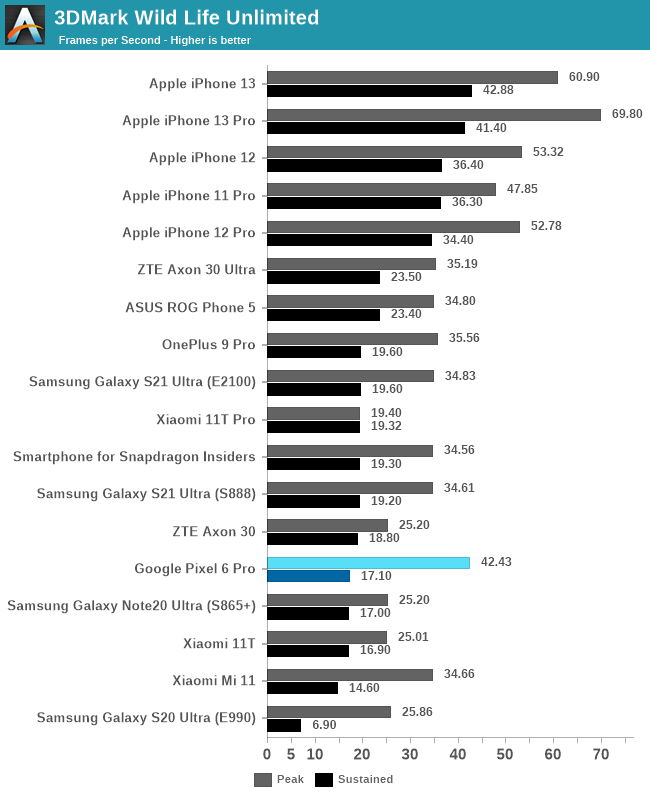
In 3DMark Wild Life unlimited, the first thing to note is that for some reason the regular Pixel 6 didn’t want to run the test as it errored out due to memory – I’m not sure what happened here, but it was isolated to the baseline model as the Pro unit had no issues.
The Pixel 6 Pro’s peak performance is respectable, however it’s only 21% faster than the Exynos 2100, not exactly what we’d expect from 21% more cores. A large issue with Mali GPUs of late has been that while you can throw more shader cores at the issue, the shared resources such as the tiler and L2 still remain as a single unit on the GPU. The G78’s ability to clock this part of the GPU higher is taken advantage of by Google in the Tensor implementation of the GPU, however that’s only 16% faster in pure clock frequency – maybe the workload is bottlenecked somewhere in this part of the GPU architecture.
Sustained performance off the start doesn’t look too good for the Pixel 6 Pro as it throttles considerably once the device gets hot, more on this in a bit.

In Basemark GPU, the Pixel 6 phones both showcase odd peak performance figures that are way lower than we expected, here the chip doesn’t even manage to outperform the Exynos 2100. I’m not sure what the technical explanation here is, as on paper, the chip should be faster.

In Aztec High, the peak performance of the Tensor is again below what you’d expect, at +14% vs the Exynos 2100, and slightly ahead of the Snapdragon 888.
Sustained performance is quite bad here, and especially the Pixel 6 Pro seems to be running more severe throttling than the Pixel 6.
Looking at the power consumption of the phones, at peak performance, the Pixel 6 lands in around 7.28W, however this figure is a bit misleading. In actuality, the phone is running peak power figures in excess of 9-10W, but this is so much power, that the SoC isn’t able to complete a single run of the benchmark without throttling, so average power for a given run is actually much lower. This would also explain as to why our peak performance figures are less than what’s expected of a GPU clocked this high, it simply can’t maintain that speed for long enough to give off an FPS figure at the peak frequencies.
At sustained frequencies, the Pixel 6 and Pixel 6 Pro end up with different spots, however both are at quite low power figures around 3W.

Aztec normal shows similar results, peak performance of the GPU is barely any better than the smaller configuration Exynos 2100 unit, and sustained performance figures are also significantly lower.
Sustained power after throttling on the phones is also quite weird here, as the phone seemingly throttles to <3W on the SoC. The Pixel 6 for some reason appears to have better power characteristics, it’s possible that chip bin has lower power than my 6 Pro unit.

Manhattan 3.1 shows a similar peak and sustained performance standing, which isn’t too favourable for the Tensor.
Power levels in Manhattan are higher than the Aztec benchmarks, I think the CPUs, or the DRAM contribute to more of the power due to the higher achieved framerates, and it slightly helps the heat dissipation rather than having everything focused on the GPU.
Overall, the GPU performance of the Google Tensor is quite disappointing. On paper, the massive G78MP20 GPU seemed like a juggernaut at the frequencies Google delivers the chip in, but in practice, it doesn’t reach the theoretical levels of performance. That being said, over the last year of SoC releases, almost every vendor in the industry has introduced some absurd ultra-high-power GPU configuration that throttles quickly. Why they do this, I don’t know, GPU compute for burst performance is always one of the reasons given, so maybe Google is also aiming the GPU towards compute rather than gaming.
In terms of sustained performance levels, the larger GPU in theory should have allowed it to run at lower frequencies, thus at better efficiency, and in turn deliver more performance than a smaller implementation like that of the Exynos 2100. The reality here is that the Pixel 6 phones struggle with thermal dissipation, and it’s something that seems to be completely unrelated to the chip itself.
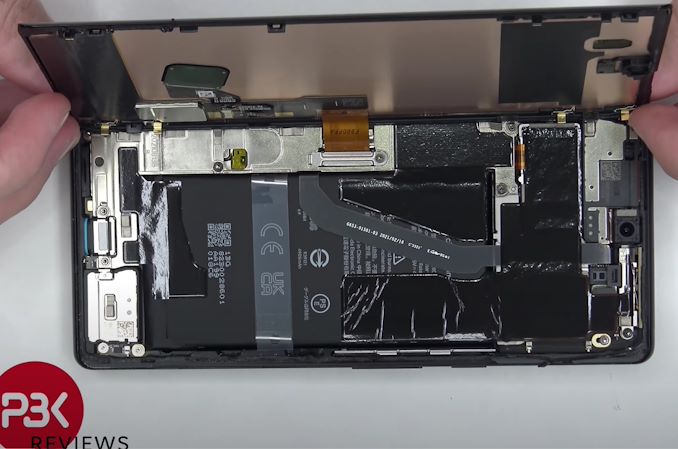
Source: PBKreviews
Both the Pixel 6 and Pixel 6 Pro are quite special in their hardware designs, in that they’re one of the rare Android devices out there which adopt an internal hardware design which doesn’t have a midframe adhered to the display panel. Looking at various teardowns of the phone, we can see that the display is relatively easily removable from the rest of the phone body, a design that’s actually more similar to Apple’s iPhones than any other Android flagship. This bodes well for the repairability of the screen, but it doesn’t do well for the thermal dissipation of the SoC. Much like iPhones have issues with thermal dissipation, and having much lower sustained power levels under stress, the Pixel 6 phones also suffer from the same issue as they cannot effectively use the display panel as a heat sink. This comes in contrast with other flagship Android devices – the Galaxy S21 Ultra for example has its display panel adhered to the midframe of the phone, it's not great for repairability, but it allows Samsung to employ a gigantic thermal dissipation pad the size of half of the phone footprint, with a direct heat pathway from the SoC to the display. Other thermally optimised devices out there share similar designs, able to better dump heat onto the full body of the phone.
The Pixel 6 Pro in contrast, has quite stark heat spots, with the left side of the phone, near the SoC, getting quite hot at up to 45°C, but at the same time the right side of the device here barely reaches 30-33°C, which is a large temperature gradient and signifies bad heat transfer abilities. Also, while I’m not sure how other people feel about this, but it does make the Pixel 6 phones feel more “hollow” in their build quality, but that might just be a nit-pick.
In any case, the Google Tensor’s chip gaming performance might be adequate, it’s no better than the Exynos 2100, and it gets further handicapped by the thermal design of the Pixel 6 phones. Generally, one can say it’s not the best phone for high-end gaming, which lines up with the subjective experiences with the devices in actual gaming demanding games like Genshin Impact.


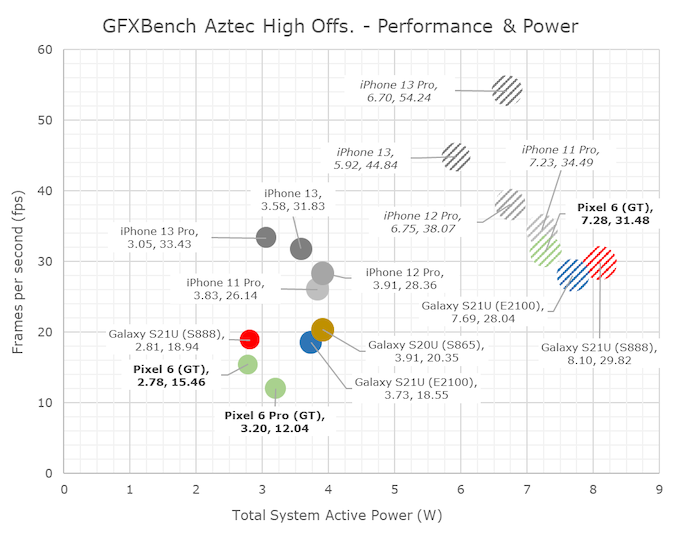
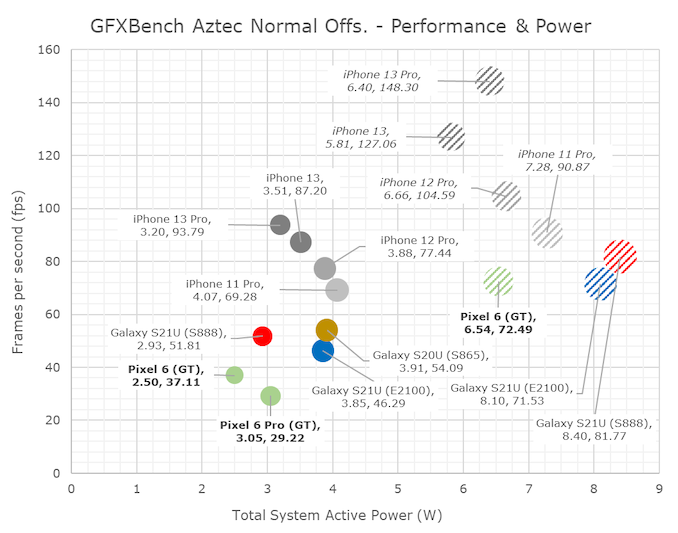
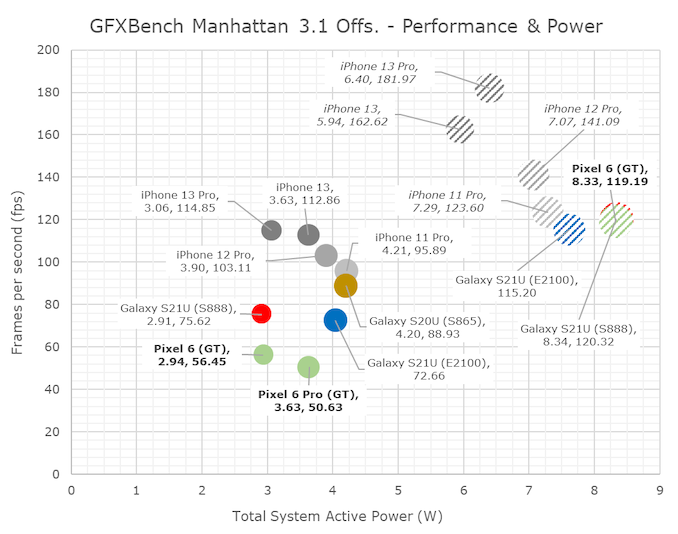








108 Comments
View All Comments
Alistair - Wednesday, November 3, 2021 - link
It's the opposite, the iPhone is massively ahead in performance, but every high end phone takes the same high end photos... you got the same photos but a lot less performance...aclos3 - Saturday, November 6, 2021 - link
I took some time to really test the camera and you are simply wrong. I have been photographing with it heavily for the last couple of days and the camera is incredible. Call it a gimmick or whatever, but the way they do their photo stacking puts this phone in a league of its own. If your main use case for a phone is benchmarking, I guess this is not your device.Lavkesh - Thursday, November 11, 2021 - link
Everyone and their grand mother do image stacking. iPhone is almost as good if not better even with a smaller sensor when compared to the latest Pixel. How's that for "in a league of its own"?Amandtec - Wednesday, November 3, 2021 - link
I don't doubt the veracity of your comment but I find the hostile undertone somewhat curious.damianrobertjones - Wednesday, November 3, 2021 - link
But... but... they said that it's amazing!! Who do I believe? /sZoolook - Saturday, November 6, 2021 - link
As long as they use Samsung process they will be hopelessly behind Apples Socs in efficiency unfortunately, would be interesting to see SD back on TSMC process for a direct comparison with Apple silicon.Tigran - Tuesday, November 2, 2021 - link
Performance looks very disappointing. Google promised 4.7x GPU performance improvement vs Pixel 5.singular9 - Tuesday, November 2, 2021 - link
I was enjoying how the speculation about the GS101 were claiming its "not far behind" the SD888. I was never expecting google to make another high end device, let alone one that undercuts most of the competition, as its just not what trends would say.I am not impressed. As someone who was rather hopeful that google would take control and bring us android users a true apple chip equivalent some day, this is definitely not the case with google silicon.
Considering how cookie cutter this design is, and how google made some major amateur decisions, I do not see google breaking away from the typical android SOC mold next generation.
Looking back at how long it took apple to design a near 100% solo design for the iPhone (A8X was the first A chip to use a complete inhouse GPU and etc design, other than ARM cores), that is a whopping 4 and a half years. Suppose this first google "designed" chip is following the same trend, an initial "brand name" break away yet still using a lot of help from other designs, and then slowly fixing one part at a time till its all fixed, while also improving what is already good, I could see google getting there by the Pixel X (10?). But as it stands, unless google dedicates a lot of time to actually altering Arm's own designs and simply having samsung make it, I don't see Tensor every surpassing qualcomm (unless samsung has some big breakthrough in their own CPU/GPU IP which may or may not come with AMD's help).
As the chip stands today, its "passable", but not impressive. Considering Google can get android to run really well on a SD765G, this isn't at all surprising. The TPU seems like a nice touch, since honestly, focusing on voice is more important than on "raw" cpu performance or something. I have always been frustrated with speech to text not being "perfect" and constantly having to correct it manually and "working around" its limitations. As for my own experience with the 6 Pro, its bloody good.
Now to specifics.
The X1 chips do get hot, as does the 5G modem. I switched the device to LTE for now. I do get 5G at home and pretty much most places I go, and it is fast, its not something I need right now. I even had a call drop over 5G because I walked around a buildings corner. Not fun.
The A76 excuse I have heard floating around, is that it takes up less physical die space, by A LOT. And apparently, there was simply no room for an A77 or A78 because the TPU and GPU took up so much room. I don't understand this compromise, when the GPU performance is this mediocre. Why not simply use the same GPU size as the S21 (Ex2100) and give the A78's more room? Don't know, but an odd choice for sure.
The A55 efficiency issues are noticeable. Try playing spotify over bluetooth for an hour, and watch the battery drain. I get consistently great standby time, and very good battery life when heavily using my device, but its these background screen off tasks that really chug the battery more than expected.
Over all though I haven't noticed any serious issues with my unit. The finger print scanner works as intended, and is better than my 8T. The camera does just as well if not better than the previous pixels. And over all...no complaints. But I wonder how much of this UX comes from google literally brute forcing their way with 2 X1 cores and a overkill GPU, and how much of it is them actually trying.
As for recommendations to google for Tensor V2, they need to not compromise efficiency for performance. This phone isn't designed to game, cut the GPU down, or heck, partner with AMD (who is working with samsung) to bring competitive graphics to mobile to compete with Adreno from QComm. 2 X1 cores, if necessary, can stay, but at that point, might as well just have 4 of them and get rid of all the other cores entirely and simply build a very good kernel to modulate the frequency. Or make it a 2+6 design with A57 cores. As someone who codes kernels for pixels and nexus devices for a long time, trying to optimize the software to really get efficiency out of the big.LITTLE system is near impossible, and in my opinion, worthless unless your entire scheduler is "screen on/off" based, which is literally BS. I doubt google has any idea how to build a good CPU governor nor scheduler to truly make this X+X+X system even work properly, since I have yet see qcomm or samsung do it "well" to call commendable.
The rest of the phone is fine. YoY improvements are always welcome, but I think the pixel 6/pro just really show how current mobile chips are so far behind apple that you might as well give up. YoY improvements have imo halted, and honestly no one seems to be having the thought that maybe we should cut power consumption in half WITHOUT increasing performance. I mean...the phones are fast enough.
Who knows. We will see next year.
PS: I also am curious what google will do with the Pixel 6A (if they make one at all). Will it use a cut down GS101 or will it get the whole chip? It would seem overkill to shove this into a 399$ phone. Wonder what cut downs will be made, or if there will be improvements as well.
sharath.naik - Tuesday, November 2, 2021 - link
Good thoughts, there is one big issue you missed. Pixel camera sensors 50mp/48mp being binned to 12mp yet Google labeled them as 50mp/48mp. Every shot outside the native 1x,4x is just a crop of the 12mp image including pottaitk3mp crop) and 10x(2.5mp crop}.teldar - Thursday, November 4, 2021 - link
You are absolutely a clueless troll and should go back to your cave. Your stupidity is unwanted.